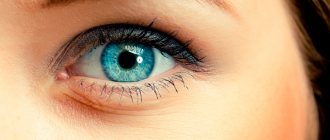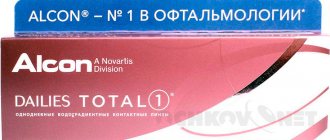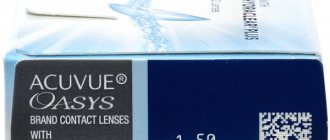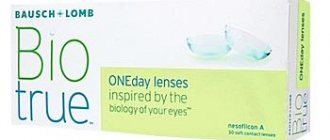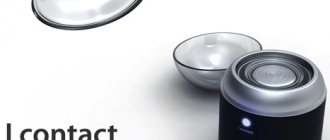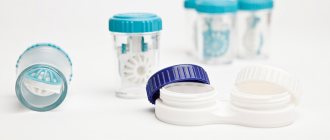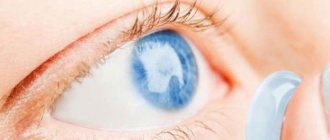Colored lenses have long ceased to be an attribute of informal parties and costume parties. Today, this is a great way to temporarily change your image while simultaneously correcting your vision. Colored lenses can change the color of the iris to a radically opposite one or only slightly giving the desired shade.
Share
Tweet
Share
Cool
Send
Classification of colored lenses
Lenses are divided into large classes depending on certain properties. Classification occurs according to the main characteristics:
Availability of diopters
They may not be present in decorative lenses when vision correction is not required. But the most popular are options with diopters, which can be of several types:
Correct astigmatism
This disease is expressed in the unevenness of the surface of the cornea or lens. For this reason, the light is refracted incorrectly, which leads to incorrect perception of colors, as well as out-of-focus images. To neutralize the consequences of pathology, special toric lenses are needed. You can apply a design of any color to them.
Find out more about lenses for astigmatism here.
For farsightedness
This disease, farsightedness, causes a person’s vision to deteriorate when viewing objects at close range. To correct this deficiency, you will need lenses with positive diopters. They will help return focus to normal values.
Necessary for myopia
Myopia is the opposite of the previous situation. The human eye has difficulty focusing on objects that are at a great distance. The solution will also be the opposite - lenses with negative diopters.
Multifocal
This type of multifocal lenses is intended for those people whose focus is off at any distance from close to far. They operate on the principle of progressive glasses. Over time, a person gradually begins to focus better at near, medium and far distances. Such lenses are divided into subtypes, each of which has a different effect on a person's ability to focus at a certain distance.
Reviews from owners of multifocal lenses can be found in the article.
Dyeing method
The coloring method is of little interest to inexperienced users. But depending on the purpose for which color options are purchased, the painting method will change. If you need to completely change the shade of your eye, then you need colored ones.
They are painted over tightly so that the real color of the eyes is not visible through them. Sometimes users simply want to enhance their natural eye color, making it rich, light or dark. Then you should pay attention to the tint options. They have a tint and are painted less densely.
There is such material
Lenses are made from one main material - hydrogel, sometimes silicone is added. Each of these options has advantages and disadvantages.
Production of hydrogel
Hydrogels are the choice of those who have budget restrictions. It’s easy to get used to, and also to select or replace lenses. For a low cost, you will have to be content with poor ability to transmit moisture and oxygen. This leads to rapid eye fatigue; wearing during the day will be problematic. Also, lenses must be removed every night.
There are silicone hydrogel ones (you can sleep in them at night)
The material eliminates the disadvantages of pure hydrogel. They allow moisture to pass through well, the breathability coefficient is several times higher than the minimum level, and there is no need to take them off at night. The negative points are the price, a long period of adaptation and a high chance of an allergy to the material.
The difference between hard and soft lenses can be found here.
You need to select the material individually for yourself. Relying on other people's feelings may be inappropriate; the body's reaction is unique to each person.
Time of use and wearing: two weeks, a month, three, a year
This item depends on the specific manufacturer, the solution in which the lenses are stored, the material used in the production, as well as on the wearer. Based on the time of use, there are 3 main periods:
- one-day;
- period;
- annual
From the names it is clear for what period they can be worn.
Based on the time of continuous wearing, there are 4 main types:
- daytime;
- flexible schedule;
- weekly;
- continuous wearing.
A flexible schedule means about 2-3 days of continuous wearing, and the last point usually means a month. Which lenses are more convenient, one-day or two-week ones, is described here.
Cost and purchase
Oddly enough, many people to this day believe that high-quality products cost a fortune, but in reality their prices are very affordable. As for colored ones, now there are a huge variety of them available and you can choose them by type and frequency of replacement.
And in these days of online shopping, the prices and availability of contact lenses are really encouraging. For example, high-quality one-day colored lenses can be purchased on the Internet for a price starting from 150 rubles. But for an amount of around 1300-1400 rubles you can purchase a whole monthly set of “one-day items” .
You can buy two-week contact lenses even cheaper. In optical stores, at a price of about 1,400 rubles, customers are offered a set of Acuvue 2 Colors, which consists of 6 blisters, with which you will not have to worry about purchasing new contact lenses for a month and a half.
But a really economical option is contact lenses from FreshLook. FreshLook ColorBlends products must be replaced only after a month; they are sold individually only at a price of about 270 rubles.
If you intend to purchase the highest quality and reliable lenses, you should pay attention to the following manufacturers of these products:
- EOS.
- Lensman.
- Dreamcom.
Kinds
To choose the right option, you should know the main types of colored lenses:
| Tinted, tint | It is not intended to completely change the color, but to give the desired shade or saturation of the natural one. Such lenses are painted loosely, remaining translucent. They give the best effect when used with bright eyes, but on dark eyes there will be practically no changes. |
| Opaque | They completely allow you to change your eye color. Suitable for any natural colors; it is impossible to see the real shade through them. When choosing, you should carefully look at how the drawing is drawn. This directly affects the naturalness of the eyes. |
| Corrective | They change the shade, like the first copy, and have the function of vision correction for those who have problems with this. |
| Cosmetic | Useful when it is necessary to hide the effect (defect) of the eyes. Usually made to order, they completely replicate the natural color and pattern of the owner’s iris. However, it is possible to make them in color. |
| Therapeutic | Used for increased eye sensitivity to sunlight. Protects them from the external environment, reducing the negative impact. |
| Carnival (Crazy-lenses) | A variety for entertainment only. They can have any color and pattern. They complement images at themed parties, making an iris like a cat’s, a vampire’s, in the shape of a heart, a cross, the sun, and anything else your imagination can create. It’s just that they are rarely worn like that, and only by people for whom a non-standard appearance is a way of life. And you can’t wear such lenses for more than a day. |
Benefits of white lenses
Of course, now many are tormented by the question of which colored lenses are better. In the meantime, we will study the advantages of white lenses:
- They complement the style with an alluring and captivating eye shade.
- Contribute to the manifestation of individuality of nature.
- Draw the attention of everyone present to the object.
In general, in the modern world, design solutions are so amazing that sometimes they simply amaze the imagination.
Today, leading specialists from companies that develop products used in contact correction successfully interact with famous designers. As a rule, as a result of their work, an incredible number of variations of carnival (decorative) and scleral lenses appear.
The basic difference between carnival lenses is that they have an unusual design or an interesting picture. But scleral lenses completely cover the cornea of the eye with a single color.
By the way, specialists have also developed white lenses for the sclera. Many people claim that these are the best colored lenses. But not everyone will decide to buy them. After all, such a decision can only be made by a person who values originality, is accustomed to amaze others and does not tolerate monotony. You can be sure: a white eye that has no pupil will surprise everyone.
It should be noted that most often white scleral lenses are used by stylists in cinema, concerts and theatrical performances. In this way they create an artistic image.
Pros and cons (bad experience)
Lenses, despite a large number of advantages, also have a number of disadvantages that force many people to abandon their use:
Can soft lens dye cause harm?
Modern production involves placing a layer of dye between the main layers of the product. This minimizes eye contact. When colored lenses were first invented, this issue was relevant, but now you can get harm from such an effect if used incorrectly or if you run into a low-quality, cheap fake.
Will normal color perception change?
The perception of colors does not change when wearing tint lenses. They are made in such a way that there is space in the center for the pupil. It does not stain, without thereby interfering with the transmission of colors. Sometimes people are faced with the fact that when wearing lenses, the colors become paler and everything becomes covered with a cloudy veil. This effect is associated with the ability of the pupils to dilate and contract. At the same time, the free space of the product remains unchanged. Therefore, when the pupil dilates, it becomes larger than the area for which the lenses are designed and a light veil is formed.
If, in general, color rendition should not change, then the problem of deterioration in lateral vision is relevant. It's difficult to get used to this.
Is it clearly visible in color with diopters and how do they affect vision?
The situation is similar to color rendering. The image should be approximately the same as in non-colored lenses, except in cases where the pupil is dilated beyond the area for which it is designed.
The effect of tint lenses depends entirely on how correctly the lenses are used. If you follow the rules, as well as consult with an ophthalmologist and follow the recommendations, problems will not arise. However, it can be difficult to follow all the rules; you can simply forget some point, which will immediately increase the risks of further use. To avoid problems, you need to select a product with a specialist, follow all rules of wearing and hygiene, and change lenses according to the period specified by the manufacturer.
Are there contact optics with correction for the nearsighted and is there one for the farsighted?
Currently, colored CLs are gaining popularity, intended for the following purposes:
- elimination of farsightedness or myopia;
- change in the color of the iris.
Colored optical products consist of several layers, one of which is filled with a pigment that can give the eyes a completely new shade or enhance their natural color.
Important! Manufacturers of colored lenses with diopters reproduce the iris pattern with maximum accuracy, making the new shades look completely natural.
There are several types of colored correction lenses:
- Indicative – do not imply a radical change in eye color. This model can be of only two types: light green or light blue. The coloring layer applied to the surface of the lens is intended for ease of use; for example, such lenses are better visible in a disinfectant solution, which simplifies their removal from it.
- Tinted - they intensify the natural color of the iris by about 20%, which gives expressiveness to the look. The model is optimal for those with light eyes.
- Colored - they can not only adjust the shade of the iris, but also completely change it. Such lenses can contain from 2 to 3 pigmented layers or be plain. They are worn by people with any eye color. Luminous models also belong to this category.
- Iridescent - characterized by uneven distribution of pigment.
- Model with a completely painted surface, including the central part . Well suited for people with increased light sensitivity.
Colored lenses with diopters can have a varied palette of shades, for example:
- yellow;
- brown;
- green;
- grey;
- blue;
- swamp;
- blue;
- violet;
- cornflower blue, etc.
Important! Each dye is designed for a specific human eye color.
TOP colored lenses: optical, toric
Knowing how lenses are qualified, knowing their types and what they are all designed for will make choosing the right option easier. The question arises: which manufacturer should you pay attention to and who should you trust? It is impossible to give a definite answer to this question. You can select a list of the best representatives based on reviews from a large number of users:
Adria: look unusual for beauty
The Korean company produces products aimed at young people. Thanks to this, the products stand out from competitors with bold design solutions that may seem crazy at first glance. However, Adria lenses are well suited for creative individuals who want to stand out and surprise their peers. The positive features of the lenses from this company, in addition to originality, are moisture retention and a high percentage of oxygen permeability.
Price: 900-1200 rubles.
Alkon: you can walk for a long day (up to 14 hours)
This is a low-key option. The range offers 6 primary colors: blue, green, honey, as well as mixed ones: brilliant blue, emerald green and silver grey. Some may find this not enough, but this is not the main purpose of these lenses. They are designed for sensitive eyes, are practically not felt, and can be worn all day. The level of oxygen transmission is 5-6 times higher than normal. Price: 1000-1200 rubles.
Freshlook: can't interfere, easy to get used to
The German manufacturer offers a high quality product with the ability to combine different patterns to suit your taste. There are 6 colors to choose from: blue, purple, sapphire, green, gray and honey. Freshlook lenses do not interfere and do not create a veil in any ambient light and pupil size. Suitable for hypersensitivity. Price: 600-900 rubles.
Bausch lomb, correction for men and women
This top would not be correct without the most popular manufacturer of such products in the world. The palette includes (there are) the following colors: blue topaz, grey, pacific, jade, violet, emerald, aquamarine and Amazon. Not all colors can be identified by one name; you need to look in the showroom.
One of the disadvantages may be that some color options have low breathability. If this item is important, then you need to choose carefully.
Regular Biotrue lenses without hazy effect
Product from a German manufacturer. Suitable for hypersensitivity. The lenses are thin, light, and cannot be felt on the eyes. When wearing them, there is no cloudy veil. This is a budget but high-quality option that enhances and enhances the beauty of the eyes. The cost of a set of 6 pieces is 900-1000 rubles.
The advantage of this choice is that you can find it in any pharmacy. Using Biotrue lenses does not require the use of special drops. The set of colors is standard.
Multi-colored (tinted) set Biomedics
These lenses are produced jointly by British and American specialists. They have quality, detailed, natural patterns, as close as possible to natural colors, comfort, so that the eyes do not get tired after a long day.
Biomedics lenses are replaced once every 1-3 months. This item depends on the intensity of use. The disadvantages include low oxygen permeability and price.
Cost – 1500 rubles per pair.
Middle segment (from 600 rub.)
Choosing colored lenses from the middle segment is a good decision, since they delight users with good quality, the possibility of long-term wear and the most natural shade. Of the existing models, the following three can be particularly highlighted.
Air Optix (Alcon) Colors
pros
- Natural color
- Comfortable to wear
- Features thinness and softness
- Does not cause peeling
Minuses
- Sometimes there is a defect
- Severely damages vision
From 895 ₽
Hydrogel best tint lenses for eyes from lotrafilcon, made using a unique color technology, thanks to which the lenses are divided into three parts: the outer frame emphasizes the iris, the central part transforms the tone of the eyes, and the inner part adds brightness to the color with depth. They have a low percentage of moisture content and a diameter of 14.2 millimeters.
ADRIA Glamorous
pros
- Good value for money
- Comfortable wearing
- Easy to put on and no peeling
- Large color selection
Minuses
- Fish-eye effect for green and light lenses
From 990 ₽
Sensitive models made of polychem, having a moisture content of 43%, a diameter of 14.5 millimeters and an oxygen permeability of 22 Dk/t. They have a radius of curvature of 8.6. Available in green, yellow, brown, grey, blue, purple and black.
EyeMed Technologies Adore
pros
- Convenient packaging
- Large color selection
Minuses
- Poor placement of the picture
- When worn for a long time, dryness and discomfort may occur.
From 1350 ₽
Standard hydrogel models made of polymacone with a diameter of 14 millimeters, a moisture content of 45% and an oxygen permeability of 32.5 Dk/t. Large color selection. Today they are available in blue, yellow, green, grey, blue and purple. Suitable for any type of vision.
Is it possible to try on different lenses when purchasing: conditions
It is necessary to try on lenses when purchasing; you can make a purchase without trying them on if it is not the first time and you know exactly what parameters the product should have. When you first buy them, you need to try them on; if there is no discomfort at first, then wear them for about an hour. Only after this will it be clear whether this option is suitable or not. If you do not carry out this procedure, then the selected option may turn out to be so inappropriate that there will be no point in using it.
Many people doubt the correctness of this procedure. If you let everyone try it on, then this is a serious violation of hygiene. But in this case, disinfection must be carried out after each user; storage is carried out in a special solution that reduces the risk of microbes surviving after disinfection. For people with serious illnesses, it is recommended that products be made to order. This will speed up the selection process and also prevent the spread of the disease.
How to choose the best quality shades
Tinted lenses are purchased to obtain a unique shade by mixing the color of the product with natural ones, or to enhance the real color. Due to the fact that the color is not solid and does not completely cover the eye, it is more difficult to choose the right “glass”; the latter require care when choosing.
Find out about cheap lenses in this material.
Key points to pay attention to:
- Radius of curvature. In simple terms - how convex the lens is, as well as its diameter.
- Wearing mode - how long you can wear the product without taking it off.
- Expiration date - how often you need to replace the pair with a new one.
- Optical power.
Colors are as natural and natural as possible for brown-eyed people
Tinted options will not look impressive. It is better to take a dense, solid color. Then there will be no risk that the dark iris will shine through the loose color and distort it.
Light shades (for gray-eyed, blue-eyed and green-eyed)
Almost any color or shade will do. On a light background it is easy to get a beautiful color regardless of the layer applied and look impressive.
Ultimately, you always need to rely on the color of your iris. There is never a perfectly pure color.
How to put on and remove colored lenses: remove, change
For those who use such an item for the first time, the process of putting on and taking off lenses turns into real agony. It’s impossible to keep your eyes open; they reflexively close at the very last moment.
To get used to it quickly and not make mistakes from the very beginning, you should take into account the following tips:
- Maintaining hygiene. You need to wash your hands thoroughly with soap. It would be good to treat it with a special antiseptic. After this, dry it well so as not to damage the surface with rough tap water. The towel itself should not leave lint, dust, or hair. This can cause discomfort if it gets into the eye, and sometimes leads to infectious diseases.
- To put on an unusual item for a man or woman, you need to carefully place it on the tip of your finger. It will be more convenient to do this using the index finger, but if it is more convenient for others, it is better to use it.
- The middle fingers of both hands pull back the eyelids. After this, the lens is inserted. Confident but careful movement.
- Next, you should look down, close your eyes and blink.
- To choose the right side, you need to look carefully at the product. If the edges look up, then everything is correct.
- Over time, you will be able to carry out this procedure with one hand. The product is placed on the middle finger, and the index and thumb pull back the eyelids.
- For removal everything is the same. You need to apply a little special solution to your palm. You need to put the lens here and rub it with your finger on both sides.
- To remove it, you need to look up, find the bottom edge with the pad of your finger, and then slide your finger down. The product can be removed without any problems.
When something doesn’t work out several times in a row, the body tenses up on a subconscious level, even if it’s unnoticeable. Before trying again, you should rest and calm down.
Features of wearing for the eyes, how to wear contacts
Knowing the specifics of wearing contact lenses will allow you to gain maximum experience and reduce existing risks:
- Age. There are no restrictions; in case of problems, the product can be prescribed from 1 year of age.
- Time for continuous wear. Depends on the specific model, some options may not be removed for several weeks.
- Addiction. It may be unusual for those who have not worn regular lenses before; a correctly selected lens should not be felt on the eye.
Caring for colored lenses (how to care) and expiration date
Due to the delicate area in which these products are used, soft reusable lenses also need to be cared for with special care. They need to be cleaned in liquid every time they are removed. A special solution is used for this. Plain water, boiled or purified, will damage the fragile product.
Storage (how to store)
Storage is also carried out in solution. If there is a need for disinfection, then there are special means for this. For complete disinfection, storing lenses in them costs approximately 2-4 hours. Changing the solution after each use will avoid the risk of contamination or spoilage of the product.
White lenses
And yet, which colored lenses are better? Let's look at white contact lenses. In the modern world they are very often used as an indispensable attribute of a carnival, holiday or party. After all, they can change the human image in such a way that the object stands out favorably from the general mass of people and turns into a center of attraction!
Quite recently, contact lenses were used only as a means of correcting vision defects. Today they play both a cosmetic and decorative role.
In general, many argue that white lenses are the best colored lenses for a holiday or carnival. And indeed, they suit everyone. White lenses completely change the style and make the image mysterious.
conclusions
- Colored (multi-colored) can perform all the same functions as regular ones.
- According to the description, they come in several classes and types, depending on the purpose.
- Products from the world's top manufacturers cost reasonable money and are available to almost everyone.
- You need to measure it when purchasing to see if it can cover the shade of your eyes. This is especially important if you choose a model for dark eyes. There is no need to worry about hygiene; they are disinfected after each client.
- Selecting the right shade depends on your actual eye color.
- Taking it off and putting it on at home will become easier over time; the condition is constant practice.
- You need to take care of them carefully and remember that you can walk during the day and sleep at night only in those lenses that are indicated in the instructions. In another case, it can be dangerous - this is written in the contraindications.
What to look for when choosing
Expert opinion
Slonimsky Mikhail Germanovich
Ophthalmologist of the highest qualification category. Has extensive experience in diagnosing and treating eye diseases in adults and children. More than 20 years of experience.
Any lenses, including colored ones, should be purchased only after consultation with an ophthalmologist. It is the specialist who will help you choose the brand, size and, if necessary, diopters individually, based on the characteristics of your eyes and vision. The doctor will also take into account the tendency to dry eye syndrome, conjunctivitis, and select the necessary solution and drops.
Otherwise, when choosing colored contact lenses, you should consider such aspects as:
- Purpose of purchase - if you just need slightly color-correcting models, you should give preference to tint ones;
- Wearing conditions are an important factor, especially if, due to work or study, you have to spend a lot of time at the computer or work with small parts. There are special models with a high liquid content that moisturize the eyes and reduce exposure to harmful radiation from the monitor. There are also models with a UV filter to protect your eyes from the bright sun;
- brand - you should not buy lenses from an unknown manufacturer, but contact trusted and licensed companies. In this case, you can avoid problems with eyelid irritation, inflammation, and discomfort during use.
